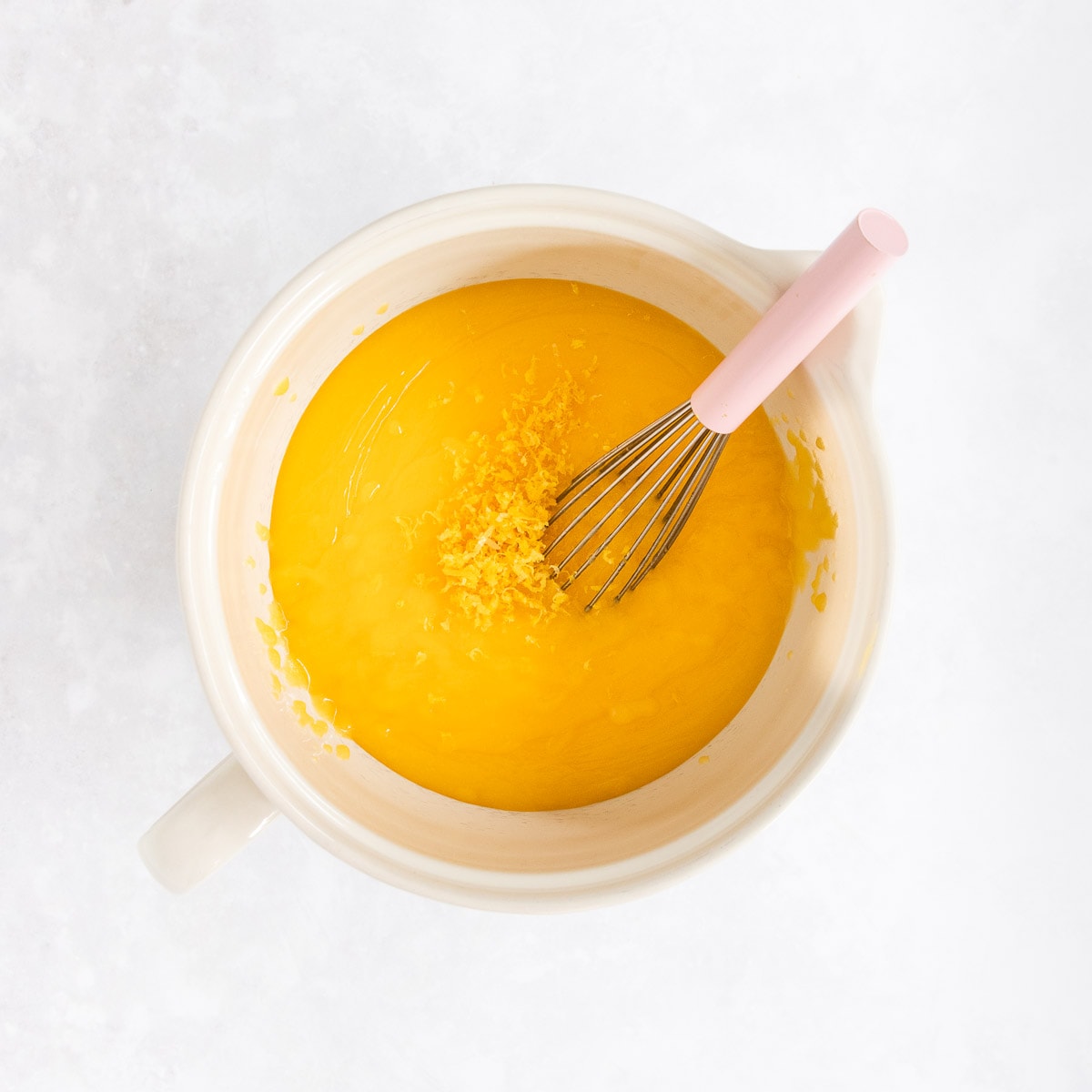Easy Microwave Lemon Curd
This post may contain affiliate links to products I recommend. I receive a small commission at no cost to you if you make a purchase using my link.
Microwave lemon curd is the easiest and most stress-free homemade lemon curd recipe you’ll ever try. With just a few simple ingredients, you’ll end up with a super smooth, super thick homemade lemon curd that is perfect for filling, spreading and topping desserts, breakfast, and anything else that takes your fancy!

You know those recipes that you try once, and immediately you know that they’re so good that you’ll never need to try another recipe for it ever again? Because you’ve found “The One”. This delicious lemon curd is definitely The One for me.
This recipe was given to me by a family friend, Barbara, so in our house, it’s known as Barb’s Lemon Curd. You’re welcome to call it that, or Microwave Lemon Curd or Easy Lemon Curd, or The Best Lemon Curd Ever but whatever you call it, it always tastes amazing and can be used in so many different ways.
What You’ll Love About This Recipe
What is Lemon Curd?
If you’ve never made lemon curd before and you don’t know what it is, it’s a sauce made with lemon juice and thickened with eggs, almost like a lemon custard.
It’s tart but also sweet (and you can adjust both the sweetness and the acidity to your liking) and it’s a super versatile recipe to have on hand when you’ve got a few lemons and need a little “something” to jazz up a dessert.
Lemon curd is also sometimes known as lemon honey or lemon butter, which may be slightly more appetising names, but I’ve always known it as lemon curd.
It can be used as a spread or as a dessert sauce. At the bottom of this post you’ll find a list of my favourite ways to use lemon curd.
The traditional method for cooking lemon curd is to make it on the stove top or over a water bath, but this microwave version is much faster and easier and especially great for beginners.
Ingredients
You only need these four ingredients to make microwave lemon curd:

🍋 Lemons – The number of lemons you’ll need for this recipe will depend on how big they are. I usually use around four medium-sized fresh lemons, although our lemon tree also grows some extremely large lemons, so I have been known to only need two. If you’re in a real pinch, you could use bottled lemon juice instead, but you will always get the best flavour from fresh lemon juice and lemon rind. You can use any variety of lemon, but keep in mind that if you use Meyer lemons your lemon curd will be sweeter, as Meyer lemons aren’t as acidic as other lemons.
🍋 Eggs – We’re using whole eggs here, and I like to use large eggs, so if your eggs are much smaller you may need to add an extra one or you’ll have a slightly less thick curd.
🍋 Sugar – Caster sugar is handy to use in this recipe as it will dissolve faster, but if regular granulated white sugar is what you have, then that will be fine too.
🍋 Butter – I prefer to use unsalted butter in curd recipes. They just really don’t seem to need salt.
Microwave Tips
As with any microwave recipe, you may need to adjust the cooking time and power level depending on your microwave.
One of the keys to microwave lemon curd (or any citrus curd, using any cooking method) is to heat it gradually after the eggs go in, to stop them from becoming scrambled eggs.
The best way to do that is to use low-medium power and cook the curd in short bursts. After each burst, give it a good stir. This keeps the temperature more even throughout the mixture and stops any “hot spots” from scrambling.
Having said that, if you do see a few small lumps or little bits of egg in the lemon curd as it cooks, don’t panic! You can strain out any little bits once the curd is done cooking.
If your microwave doesn’t have a low power option, then just cook the curd in shorter (20-30 second) bursts and stir it more often.
How to Make Microwave Lemon Curd
Be sure to check out the full instructions and ingredient list in the recipe card below

Start by zesting the lemons. A fine grater like a Microplane is best so you don’t end up with any big pieces of zest in your teeth. If you only have a coarse grater, then I recommend putting all of the lemon zest into the curd mixture at the start and then straining it all out later. You will get all of the flavour, but not the pieces.

Next, juice the lemons. Strain the juice and measure it into a large microwave-safe bowl or jug. Add in the sugar and give it a stir. Microwave it at 100% power for 2-3 minutes, stirring after each minute, until the sugar has mostly dissolved.

Then add in the butter and whisk until the butter melts.

Add the beaten eggs a small amount at a time, whisking to combine the mixture well.
Add in half of the lemon zest, then cook the curd on 50% power for 2-3 minutes, again stirring after each minute, until it starts to thicken.
Then drop the power down to 30% and cook in 30-second bursts until the curd is as thick as you’d like it. The lemon curd should thickly coat the back of a metal spoon, and leave a line when you draw your finger through it (carefully, because it’s hot!)
Keep in mind that the curd will continue to thicken as it cools.


Strain the lemon curd through a fine mesh strainer or sieve into another bowl or jug, to remove any stray pieces of cooked eggs.

Tap the sieve against the bowl to get the curd to pass through – don’t push it through with a spoon, as you’ll end up with tiny pieces of mashed egg white going through too, and we don’t want that!

Stir in the remaining lemon zest, then give the curd a taste. If it is too sweet, you can add a little squeeze of extra lemon juice. If it’s too tart, stir in a little more sugar, a teaspoon at a time, until the desired level of sweetness is achieved.
Cover the curd as described below, and allow it to cool.
The Best Way to Store Lemon Curd
If you’re using all of the lemon curd in another recipe, the easiest way to cool and store it is to leave it in the bowl or jug that you strained it into, and press a piece of plastic wrap directly onto the surface, to stop it from forming a skin as it cools.
Once the jug isn’t super hot to the touch anymore, you can put the curd into the fridge to cool completely.

If you want to store the curd in a jar or container, pour it in, filling it up to the top, then put the lid on and pop it into the fridge once it’s cooled down a bit.
The microwave lemon curd will keep for 1-2 weeks in the refrigerator.
How to Make It on the Stove Top
If you prefer to make your lemon curd on the stovetop, you can. You’ll pretty much follow all the same steps outlined above in the microwave method, but using a medium-sized saucepan on the stove, Make sure you stir the curd constantly as you’re cooking it, to avoid it catching on the bottom of the pan.
You can also use a double boiler (a heatproof glass bowl set over a pan of simmering water), however, this will take a lot longer to cook.


Ways to Use Lemon Curd
- As a filling for a lemon meringue pie
- In a cheesecake
- On this no-bake gluten free lemon slice
- Swirled through lightly whipped cream as a topping for desserts such as pavlova or meringues
- Swirled through thick greek yoghurt or coconut yoghurt as a delicious snack or breakfast with berries and some muesli or granola
- As a spread on toast, scones or waffles
- As a topping for pancakes
- As a cupcake filling
- As a cake filling (make sure you pipe a dam/ring of a firm buttercream or ganache and then fill it with the curd to stop the curd spilling out)
- As a filling for a Swiss roll cake or sponge cake
- As a filling for macarons
- As a filling for cream puffs or tart shells, with some whipped cream on top.
- As a topping for ice cream
Lemon curd also makes a great gift – pop it into some clean jars and decorate it with a nice ribbon or twine.
More lemon recipes…
Lemon Cheesecake Cups
Gluten Free Lemon Slice

Microwave Lemon Curd
Ingredients
- 150 g unsalted butter
- 160 ml lemon juice (⅔ cup)
- 300 g caster sugar (1 & ⅓ cups )
- 4 large eggs lightly beaten
- 4 teaspoons lemon zest finely grated
Instructions
- Cut the butter into smallish pieces (1cm or so, but no need to get too fussy) and set aside.
- Place the lemon juice and caster sugar into a large, microwave-safe jug. Microwave at 100% power for 2 to 3 minutes, stirring after each minute, until the sugar has dissolved.
- Add the butter, and stir with a whisk until the butter is completely melted.
- Whisk in the eggs and half (2 teaspoons) of the grated lemon zest.
- Microwave for 2 to 3 minutes on 50% power, stirring after every minute, until the curd begins to thicken.
- Then drop the power to 30% and cook in 30-second bursts until thick. If your microwave doesn’t go to 30% power, you can keep using 50% but make sure you stop and stir it often.
- While the curd is cooking, place the other half of the grated lemon zest (2 teaspoons) into a large heatproof jug or bowl, and set a sieve on top of the bowl.
- Once the curd is cooked, pour it immediately through the sieve. Give it a stir to incorporate the zest.
- Cool for 20 minutes or so, stirring occasionally, then place some plastic wrap directly onto the surface of the curd, and place in the refrigerator to cool completely. Once cold, you can use your lemon curd in your chosen recipe, or transfer it to jars or containers.
- Microwave lemon curd will keep for 1 – 2 weeks in the fridge.
Notes
Nutritional Disclaimer: Any nutritional information provided is a computer generated estimate and is intended as a guide only.





